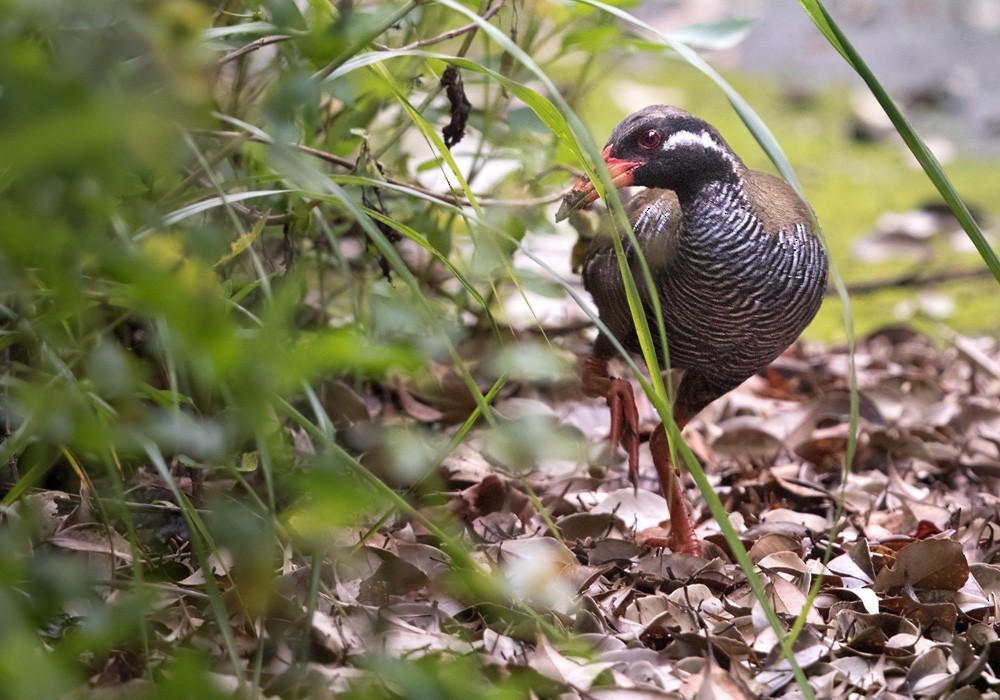Okinawa Rail
A species of Australasian-pacific Rails Scientific name : Hypotaenidia okinawae Genus : Australasian-pacific Rails
Okinawa Rail, A species of Australasian-pacific Rails
Botanical name: Hypotaenidia okinawae
Genus: Australasian-pacific Rails
Content
Description General Info
 Photo By Lars Petersson
Photo By Lars Petersson Description
It is about 30 cm long with a wingspan of 50 cm and a weight of around 435 g. It is almost flightless and has very short wings and tail. The bill is large and bright red with a whitish tip. The long, strong legs are red as are the iris and eye-ring. The upperparts are olive-brown while the underparts are black with narrow white bars. The face is black with a white spot between the bill and eye and a white line behind the eye, extending back to the side of the neck. The undertail-coverts are dark brown with pale bars. Juvenile birds are paler than the adults and are mottled white below rather than barred. The spot in front of the eye is tinged with brown while the stripe behind is shorter than in the adult. The bill and iris are brownish and the legs and feet are yellow-ochre. It is a noisy bird with a variety of loud calls. It calls most often early and late in the day, usually from the ground but sometimes from trees. Pairs often call together and up to 12 birds have been heard in one area. 
Size
30 cm
Nest Placement
Ground
Feeding Habits
Okinawa Rail primarily consumes land snails, supplemented by insects, locusts, lizards, and occasionally dead amphibians. Okinawa Rail forages mostly on the forest floor, and may also seek food in shallow waters. Animal matter predominates its diet over plant matter.
Habitat
The okinawa Rail inhabits subtropical broadleaf evergreen forests characterized by dense undergrowth, often in proximity to water such as streams, pools, or reservoirs. It thrives in both primary and secondary forests, including forest margins and smaller woodland fragments, as well as in scrublands and cultivated areas adjacent to forests.
Dite type
Omnivorous
General Info
Feeding Habits
Bird food type
Behavior
It is a poor flyer but it can run rapidly. It spends most of its time on the ground but usually roosts in trees, climbing up to sleep on a branch or sloping trunk. In the morning, it preens and stretches before dropping straight to the ground. It is usually found in dense cover but comes into the open to bathe. It bathes for short bouts of 2–4 minutes before preening for 4–20 minutes. It feeds on lizards, amphibians, snails and large insects such as locusts. Food is mainly taken from the forest floor but may also be taken from shallow water. Pairs are monogamous and appear to mate for life. The nest is built on the ground and made of leaves, grass and fern fronds. The eggs are laid between May and July and there are 2–4 in a clutch. The eggs are oval in shape and white with reddish, pinkish or brownish markings concentrated at the larger end. The downy young are black with yellowish legs and feet and a white bill with a blackish base and tip. The eggs and young are often predated by the habu (Trimeresurus flavoviridis), a venomous snake. 
Distribution Area
It is found only in Yanbaru, the northern part of Okinawa Island in the Ryukyu Islands of southern Japan, from where it gets its Japanese name. It has a total range of just 260 km. It occurs from sea-level to the highest mountains at 498 m above sea-level. In winter, some birds move lower down or move a little further south of the breeding range. It mainly occurs in evergreen broad-leaved forest but also occurs in marshes, grassland and cultivated land close to forested areas and water. Itaji (Castanopsis sieboldii) is the dominant tree in the rail's habitat but it also occurs among other trees such as Ryukyu Pine (Pinus luchuensis). It requires dense ground vegetation as well as standing water for bathing. 
Species Status
The species is classified as endangered by BirdLife International because of its small, declining population and restricted range. The total population was estimated at 1,800 birds in 1986. Surveys between 1996 and 2004 suggested a significant decline to about 720 birds and a northward contraction of the range of about 40%. However, a survey in 2006 found no further range contraction. It is threatened by the loss and fragmentation of its forest habitat due to logging, agriculture and the building of roads, dams and golf courses. Introduced predators such as cats, dogs and the small Asian mongoose probably have an impact while some birds are killed by vehicles on roads. The species is legally protected in Japan and has been declared a "Natural Monument" and a "Special Bird for Protection". Yanbaru became a national park in 1996 and several forest sites have been bought by conservation organizations as nature reserves. Trapping is taking place to reduce predator numbers and traffic calming has been introduced to some areas to reduce the number of birds killed on roads. A captive breeding program is planned for the future. The Japanese Ministry of the Environment has laid out a 10-year action plan with steps it plans to take to stabilize the species numbers. 

 Photo By Lars Petersson
Photo By Lars Petersson